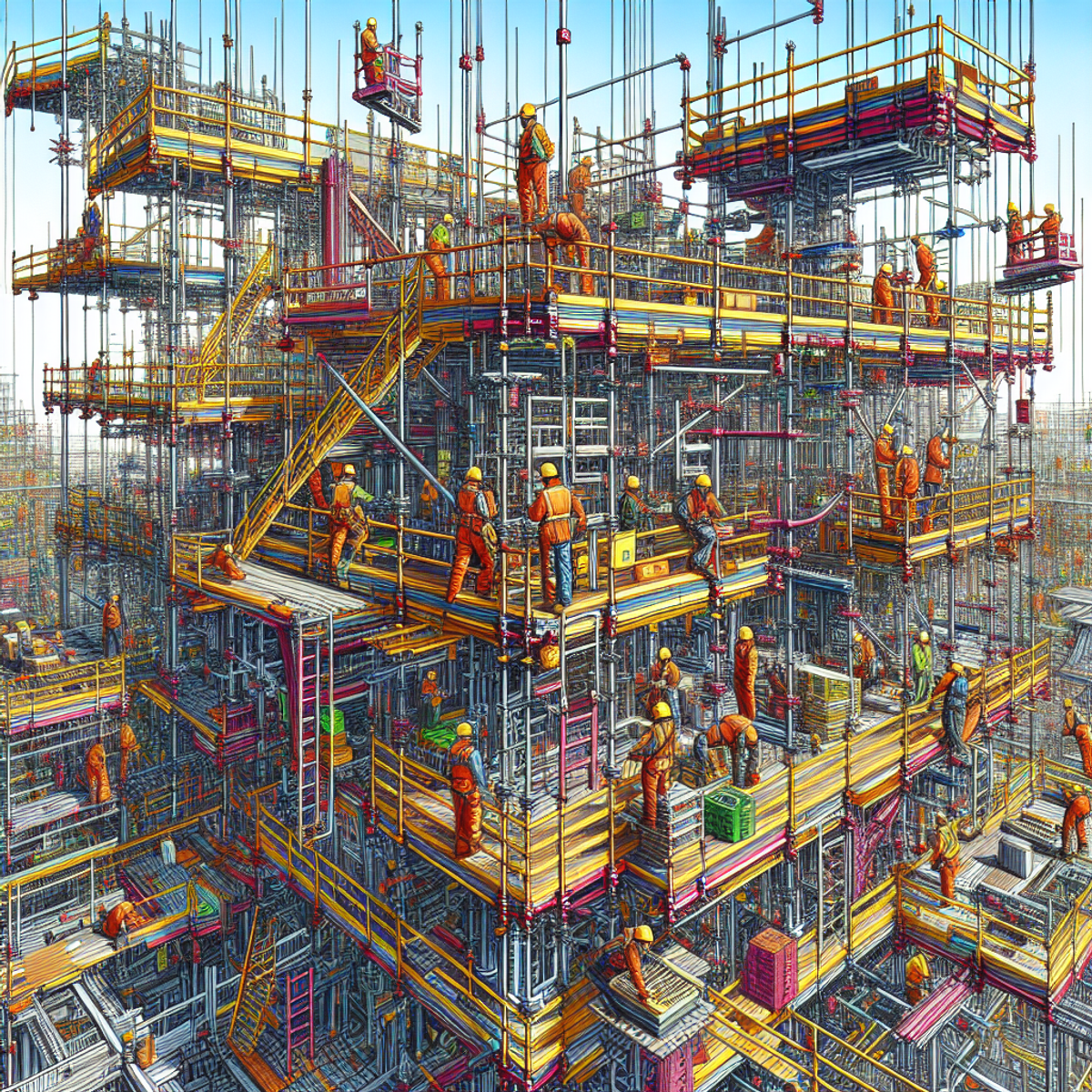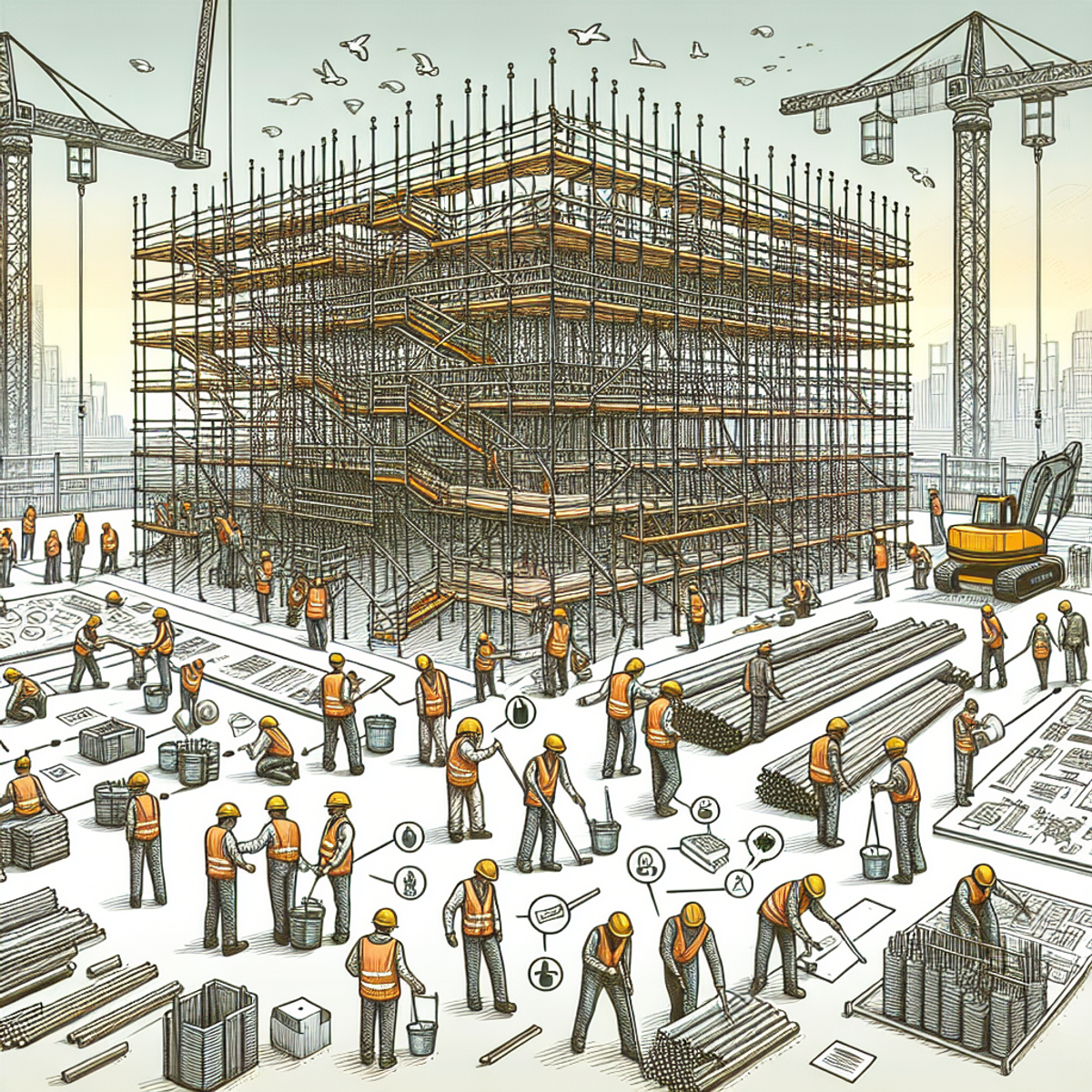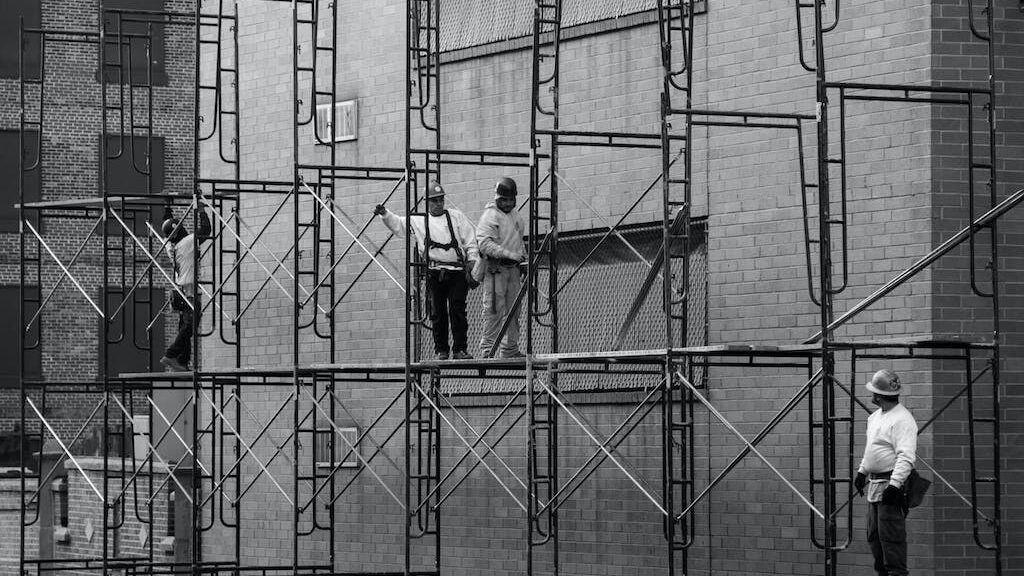Scaffolding 101: A Beginner’s Guide to Safe and Effective Use
Introduction
Scaffolding, often referred to as scaffold or staging, is an integral framework in the realm of construction. This temporary structure serves a dual purpose: it provides necessary support for workers and their materials during the construction or repair of buildings and bridges, and it grants access to heights and spaces that would be otherwise inaccessible. The pivotal role scaffolding plays cannot be overstated:
- It ensures workers’ safety by offering a sturdy platform from which they can work with confidence.
- The use of scaffolding improves efficiency on-site by facilitating quicker movement and better positioning for tasks at height.
Recognizing the crucial importance of scaffolding is only part of the equation; the other is its safe and effective use. Proper scaffold application is paramount in preventing workplace accidents—a misstep not only endangers workers but also impacts project timelines and costs. By adhering to stringent safety standards and engaging in conscientious usage practices, job sites can maintain high levels of productivity while safeguarding their most valuable asset—people.
A Brief History of Scaffolding
The origins of scaffolding date back to ancient civilizations, including the Egyptians and Chinese, who used early versions of these structures in the construction of their famous buildings.
Ancient Egypt
The remarkable pyramids stand as a testament to the engineering prowess of the ancient Egyptians. Scaffolding likely played a crucial role in assembling these monumental structures, providing support for workers as they carefully placed each stone block. These temporary frameworks had to be strong and stable, allowing builders to work at great heights safely.
Click here to learn more about Ancient Egypt
Ancient China
Similarly, the Chinese utilized bamboo scaffolds extensively due to the abundance and durability of bamboo. Even the Great Wall, one of history’s most massive building projects, employed these early scaffolds. They enabled workers to perform intricate tasks on vast vertical surfaces.
Throughout history, numerous tall edifices owe their existence to advancements in scaffolding. Here are some notable examples:
- The Colosseum: Constructed in Rome around 70-80 AD, this ancient amphitheatre would have been impractical to build without some form of scaffold system supporting workers at different levels.
- Cathedrals and Castles: During the medieval period, European cathedrals and castles soared upwards with the aid of elaborate wooden scaffoldings, demonstrating both their artistic vision and structural necessity.
- Modern Skyscrapers: The advent of steel frames ushered in a new era for tall buildings, accompanied by tubular steel scaffolding. This innovation played a pivotal role in erecting the towering skyscrapers that define today’s city skylines.
These examples highlight the vital role scaffolding has played throughout history – enabling humanity to construct vertically and accomplish architectural wonders that still evoke wonder centuries later. As we explore specific types of modern scaffolding systems, it’s important to remember that they all build upon this rich historical legacy, continuing a tradition that combines practicality with endless potential.
More about the History Of China
Ancient China’s use of bamboo scaffolding for constructions like the Great Wall showcases an early mastery of sustainable building techniques, marrying resourcefulness with architectural ambition.
1. Tube and Coupler Scaffolding
Tube and coupler scaffolding is a versatile and strong system used in construction. It consists of two main parts:
- Tubes: Steel or aluminium pipes that create the scaffold’s framework.
- Couplers: Also called fittings or clamps, these connect the tubes.

How Tube and Coupler Scaffolding Works
The strength of this type of scaffolding lies in its ability to be assembled in different ways, making it suitable for various building shapes and sizes. Here’s how it works:
- Standards (Vertical Tubes): These are the vertical columns of the scaffold.
- Ledgers (Horizontal Tubes): They connect the standards horizontally.
- Transoms: Placed across ledgers, these support platforms or decking.
- Braces: Diagonal tubes that provide stability and strength.
By following specific guidelines, such as the European Standard BS EN 12811-1, which covers load capacities and safety practices, tube and coupler scaffolds are designed to be safe and reliable.
The Importance of Ledgers in Tube and Coupler Scaffolds
Ledgers play a crucial role in providing horizontal support within the scaffold structure. They are positioned at regular intervals along the vertical standards, creating a stable framework that can hold workers and materials.
Advantages of Tube and Coupler Scaffolding
Here are some reasons why contractors choose tube and coupler scaffolding for their projects:
Flexibility: Fits Any Building Design
Since it can be customized using different configurations, tube and coupler scaffolding can adapt to any building shape or contour.
Strength: Handles Heavy Loads
Made of steel, this type of scaffold is incredibly sturdy and can support heavy loads without compromising safety.
Durability: Withstands Harsh Weather
When properly maintained, tube and coupler scaffolds are durable and can resist tough weather conditions.
Limitations of Tube and Coupler Scaffolding
While tube and coupler scaffolding offers many benefits, it also has some limitations that should be considered:
Time-consuming Assembly
Due to its numerous individual components, setting up tube and coupler scaffolds takes more time compared to other types of scaffolding systems.
Labor-intensive Installation
Skilled workers are required to assemble this type of scaffold correctly, which can result in higher labour costs.
Weight Considerations
Steel tubes used in tube and coupler scaffolding are heavier than alternatives like aluminium, which may affect transportation and setup efficiency.
By understanding the ins and outs of tube and coupler scaffolds — from their parts to their practical uses — you can take advantage of this system’s versatility while ensuring safety on your construction projects.
Check out our Scaffolding options and choose the one that suits you the best!
2. Prefabricated Modular System Scaffold

Prefabricated modular system scaffold – a term that might seem complex, but let’s break it down. When we say ‘prefabricated’, we mean components that are pre-designed and manufactured off-site. ‘Modular’ refers to the ability to combine these components in various configurations to cater to specific project needs.
A popular variant of this type is the H-frame/façade modular system scaffold. The name derives from the characteristic “H” shape formed by the main components. This scaffold system is primarily used for façade work due to its relative ease of assembly and adaptability.
Benefits of using prefabricated modular systems include:
- Quick Assembly: Pre-designed modules expedite the assembly process, saving time and resources.
- Versatility: The ability to modify configurations allows for adaptation to diverse project requirements.
- Safety: Manufactured under controlled conditions, these components offer a higher degree of safety compared with on-site fabrication.
Applications where this type of scaffold excels include:
- Façade Work: The H-frame design provides an ideal platform for facade maintenance and repair.
- Interior Work: The flexibility of configuration makes it suitable for interior tasks such as painting or plastering.
The prefabricated modular system scaffold offers a compelling blend of convenience, versatility, and safety. Yet, like all scaffolding systems, proper usage guidelines must be adhered to ensure optimal performance and safety. As we continue exploring different types of scaffolding systems, remember that each comes with its unique set of features tailored for
3. Suspended Scaffold
A suspended scaffold is a type of scaffolding that hangs from the top of a building or structure. It’s commonly used for work on vertical surfaces, making it perfect for tasks like facade work on tall buildings or painting and repair jobs. This scaffolding system consists of one or more platforms suspended by ropes or other non-rigid means from an overhead structure.

Usage Scenarios for Suspended Scaffolds
Usage scenarios for suspended scaffolds are diverse yet specific, including:
- Window cleaning on skyscrapers: Window washers use this type of scaffold to reach the building’s face while remaining at a safe distance from it.
- Exterior plastering or painting: For renovation projects requiring these tasks, suspended scaffolds offer the needed flexibility and mobility.
Safety Precautions for Using Suspended Scaffolds
However, using a suspended scaffold comes with its unique set of precautions. Here are some important safety measures to consider:
- Proper counterweighting: Ensuring balanced weight distribution is crucial in preventing the scaffold from tipping over. Follow the manufacturer’s recommendations for counterweights and avoid using construction materials or tools as substitutes.
- Regular inspections: Conduct thorough inspections to ensure safety during operations, including checking suspension ropes, connections, anchorages, and guardrails. Perform inspections:
- Before each work shift
- After any incident that could affect structural integrity
- During bad weather conditions
- Emergency preparedness: Have trained personnel who know how to handle emergencies involving suspended scaffolds.
Remember that working with suspended scaffolds requires precision and awareness – overlooking safety measures can lead to severe consequences. Hence, training workers about safety practices associated with these scaffolds is essential before they start operating on one.
4. Timber Scaffold
When you imagine scaffolding, you might picture timber scaffold as a traditional method that has been used for centuries. Timber scaffolding consists of wooden planks and poles, usually made from strong wood types like pine.

Advantages of Timber Scaffold
A key characteristic of timber scaffolds is their adaptability. They can be easily adjusted to fit the specific dimensions and shapes of various construction sites. This flexibility makes them ideal for jobs where customization is required. Moreover, timber scaffolds are generally cost-effective and easily available, further enhancing their appeal.
Disadvantages of Timber Scaffold
However, it’s important to consider the drawbacks of using timber scaffolds:
- Durability: Unlike metal scaffolds, timber variants are more susceptible to weather elements. Exposure to rain, heat or cold can lead to warping or splitting.
- Maintenance: Timber scaffolds require frequent checks to prevent wood rot and structural instability. The wooden components need regular treatment with preservatives.
- Load Capacity: While wood is sturdy, it does not match the load-bearing capacity of metal-based scaffolding systems.
Extending the Lifespan of Timber Scaffold
Despite these challenges, timber scaffolding remains an essential tool in many construction projects. Regular maintenance forms a cornerstone in extending the lifespan of these structures. A proactive approach includes periodic inspections for any signs of damage or rot and prompt replacements of compromised components.
The Place of Timber Scaffolds in Construction Projects
Compared with other types such as tube and coupler or modular system scaffolds, timber scaffolds might seem less advanced. Yet its proven track record in terms of adaptability and cost-effectiveness continues to make it a viable choice in construction projects where the conditions are right.
5. Bamboo Scaffold
Bamboo scaffolding, a traditional construction technology, has been used since ancient times and is still relevant today. It was famously used in the construction of the Great Wall of China, showcasing its durability and strength. Here’s why bamboo scaffolding is worth considering:
Why Choose Bamboo Scaffold?
1. Eco-Friendliness
Bamboo is known for its sustainability and positive impact on the environment. Here’s why:
- It grows quickly: Bamboo is a fast-growing plant, which means it can be harvested and replenished at a faster rate compared to other construction materials.
- It absorbs carbon dioxide: During its growth, bamboo absorbs CO2 from the atmosphere, helping to reduce greenhouse gas emissions.
By using bamboo as a scaffolding material, you’re opting for a greener choice that contributes to a lower carbon footprint in construction projects.
2. Flexibility
One of the unique properties of bamboo is its natural flexibility. This characteristic offers several benefits for scaffolding:
- Bends without breaking: When subjected to external forces like wind or minor impacts, bamboo can flex instead of snapping, providing resilience and reducing the risk of structural failure.
- Easy to work with Bamboo poles are lightweight and can be cut or shaped easily on-site, allowing for quick adjustments during construction.
Limitations of Bamboo Scaffold
Despite its advantages, some limitations make bamboo scaffolds unsuitable for certain applications:
1. Durability
While bamboo is strong, it may not withstand prolonged exposure to harsh weather conditions as well as metal scaffolding. Over time, factors like rain, humidity, and sunlight can cause deterioration and reduce its lifespan.
2. Standardization
Unlike metal scaffolding, where dimensions are standardized for easy assembly, bamboo poles vary in size and quality. This lack of uniformity can pose challenges in meeting precise construction standards, especially for large-scale projects with specific requirements.
3. Safety Regulations
Modern construction projects are subject to strict safety regulations that prioritize worker protection. Certain safety standards may require materials and designs that go beyond what traditional bamboo scaffolding can provide, such as higher load-bearing capacities and enhanced fall protection systems.
Is Bamboo Scaffold Right for Your Project?
While bamboo scaffolds may not always meet the needs of today’s high-rise buildings or complex architectural designs, they remain a viable option for smaller-scale projects that benefit from their unique properties and historical significance.
Before choosing bamboo as your scaffolding solution, consider factors such as project size, duration, location, and specific safety requirements. Consulting with a structural engineer or construction expert can help determine whether a bamboo scaffold is suitable for your particular project.
Essential Safety Considerations in Scaffolding Work
Safety should always be the top priority when it comes to scaffolding work. Making sure that the scaffold structure is secure and stable is crucial in preventing accidents and ensuring the well-being of workers.

The Importance of Strong Foundations
A solid foundation is the starting point for a safe scaffold structure. It serves as the connection between the scaffold and the ground, providing stability and support. Failing to properly secure or level the scaffold’s base can result in dangerous situations such as instability, tipping, or even collapse.
Ensuring Stability Measures
Stability measures work hand-in-hand with foundations to enhance the safety of the scaffold. These measures include:
- Evenly distributing load: Properly distributing weight across the scaffold helps maintain its balance and prevents overload in specific areas.
- Levelling the scaffold: Ensuring that the scaffold is set up on a flat surface reduces the risk of it being uneven and unstable.
- Securing against movements: Using appropriate methods to secure the scaffold, such as tying it to adjacent structures or using stabilizers, helps prevent unexpected shifts or swaying.
By implementing these stability measures alongside a strong foundation, you can create a secure working environment on top of the scaffolds.
Understanding Scaffold Ties for Added Support
Scaffold ties are essential components for enhancing stability in scaffolding. These ties connect the scaffold to nearby structures or buildings, providing additional support. Here are the different types of scaffold ties commonly used:
- Through ties: Pass through square openings on the structure’s walls.
- Box ties: Anchored to two points on the structure’s surface.
- Lip ties: Secured around a suitable column or beam.
Each type has its purpose and application depending on factors like job site conditions and building design.
Utilizing Brackets for Extra Working Space
Another way to add support to your scaffolding system is by using brackets. These brackets create additional working platforms at various levels, allowing workers to perform tasks with ease. It’s important to follow the manufacturer’s instructions when installing brackets to ensure proper usage and safety.
Importance of Compliance with Recognized Standards
When it comes to any construction project, following regulations is crucial. This is especially true for scaffolding work due to its inherent risks. The European Standard BS EN 12811-1 serves as a comprehensive guideline for scaffold design and usage. It covers important aspects such as load capacities and safety requirements for different types of scaffolding systems. Adhering strictly to these standards not only keeps you compliant but also ensures that your scaffolding setup is safe and reliable.
Creating a Safe Working Environment
In summary, every aspect mentioned above plays a vital role in ensuring the safety of scaffolding work:
- Strong foundations
- Stability measures
- Scaffold ties
- Brackets
- Compliance with recognized standards
By carefully considering and implementing these safety measures, you can establish a work environment that prioritizes both productivity and worker well-being
Boost your project’s safety standards with our state-of-the-art scaffolding. Explore our options to secure and streamline your construction efforts. Safety first, success always!
Guidelines for Safely Using Scaffolding Systems
Ensuring the safe use of scaffolding systems involves meticulous attention during every phase, from assembly to dismantling. The following steps provide a structured approach to maintaining safety standards throughout the scaffold’s lifecycle.
Assembly
- Preparation: Before erecting scaffolding, ensure that all components are on-site, undamaged, and suitable for use.
- Foundation: Start with a solid foundation, using sole boards and base plates to distribute weight evenly.
- Framing: Erect standards, ledgers, and transoms securely. Follow manufacturer guidelines or a professional engineer’s design.
- Bracing: Attach diagonal braces to provide rigidity and prevent swaying.
- Decking: Lay planks tightly with no gaps greater than 1 inch unless designed for specific purposes.
- Guardrails and Toeboards: Install at all open sides to prevent falls and dropped objects.
Dismantling
- Reverse Order: Carefully dismantle the scaffold in the reverse order of assembly.
- Inspection: As each piece is removed, inspect it for damage before setting it aside.
- Clear Area: Keep the area below clear of personnel and unsecured materials.
Inspection
Regular inspections are non-negotiable for maintaining scaffold integrity.
- Pre-Use Inspection: Conduct daily before work begins to check for wear or adjustments needed due to environmental conditions.
- Post-Assembly Inspection: Have a competent person inspect the scaffold after assembly, any alteration, or after adverse weather.
- Record Keeping: Maintain logs of all inspections for accountability and historical data.
Maintenance
Proper maintenance ensures longevity and safety.
- Cleaning: Remove debris, mud, or slippery substances from platforms regularly.
- Parts Replacement: Substitute damaged or weakened parts immediately with matching components from the same manufacturer.
Training and Certification
Investing in knowledge pays dividends in safety and efficiency.
- Formal Training: Equip workers with the knowledge to recognize hazards through comprehensive training programs.
- Competency Certification: Encourage obtaining certifications that validate an individual’s ability to safely work with scaffolding.
By embracing these practices, you lay a foundation for not only regulatory compliance but also for creating a culture of safety that transcends mere adherence to rules.
What is tube and coupler scaffolding?
Tube and coupler scaffolding is a versatile and strong system that consists of steel tubes and various types of clamps or couplers, providing flexibility, strength, and durability in construction projects.
What are some advantages of tube and coupler scaffolding?
Some reasons why contractors choose tube and coupler scaffolding include its flexibility to fit any building design, ability to handle heavy loads, and its durability to withstand harsh weather when properly maintained.
What are the limitations of bamboo scaffold?
Despite its eco-friendliness and flexibility, bamboo scaffold may not always meet the needs of modern construction projects due to concerns about durability, standardization, and compliance with safety regulations.
Why is safety important in scaffolding work?
Safety should always be the top priority when it comes to scaffolding work, as it ensures a safe working environment, stability measures, compliance with recognized standards, and the utilization of strong foundations for added support.
What are some guidelines for safely using scaffolding systems?
Ensuring the safe use of scaffolding systems involves meticulous preparation before assembly, careful dismantling in reverse order, regular inspections for maintenance, proper cleaning for longevity and safety, as well as investing in training and certification for knowledge in safety and efficiency.
Conclusion
The safe and effective use of scaffolding stands as a cornerstone in construction operations. Both workers and employers must commit to rigorous safety standards to prevent accidents and ensure that projects are completed without incident. The responsibility extends beyond mere compliance; it is about fostering a culture where safety permeates every action on the job site.
Scaffolding systems, in their various forms, have revolutionized the way buildings rise into the sky. Their versatility not only makes formidable projects possible but also significantly enhances efficiency. However, this efficiency should never overshadow the well-being of workers who navigate these temporary structures daily.
The industry must continue to advance, adopting new materials and technologies while holding fast to the principle that no task is too urgent or important to bypass the necessary precautions. As scaffolding continues to evolve, so must the dedication to safeguarding those who work at heights—ensuring that every scaffold is a platform for safe practice as much as it is for construction progress.
Remember, when you step onto a scaffold, you’re not just building structures; you’re upholding a legacy of safety and responsibility that underpins the entire construction industry.
Elevate your projects with our top-tier scaffolding solutions! Click to explore our range and ensure your construction stands tall. Ready to build smarter and safer? Let’s get started!


